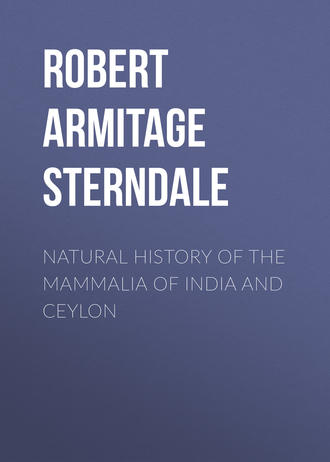 полная версия
полная версияNatural History of the Mammalia of India and Ceylon
This genus is also distinguishable from the last by the form of the ear conch, the small size of the anti-tragus, and, as Dr. Dobson particularly points out, by the presence of two joints only in all the toes, as also by the number and character of the teeth, which are as follows:—
Inc., 2/4; can., 1—1/1—1; premolars, 2—2/2—2; molars, 3—3/3—3.
NO. 54. HIPPOSIDEROS ARMIGERThe Large Horse-shoe Bat (Jerdon's No. 25)HABITAT.—Lower Himalaya ranges; Ceylon.
DESCRIPTION.—Nasal-leaf large and square; lips with a triple fold of skin on each side; tragus vaguely developed and wavily emarginate; of a uniform light-brown colour, with maroon tips to the hairs of the upper parts; membranes black.
SIZE.—Head and body, 4½ inches; tail, 2½; wing expanse, 22.
Jerdon makes this out to be the same as Kellaart's H. lankadiva and the Malayan H. nobilis, but those are synonymous with Phyllorhina diadema. Kellaart supposed it to be identical with H. insignis, which will be found further on as Phyllorhina larvata, all those bats closely resembling each other in a general way. I think this No. 25 of Jerdon is the same as Peter's Phyllorhina armigera. Hutton found it at Darjeeling, and writes of it as follows:—
"When captured alive the large ears are kept in a constant state of rapid tremulous motion, and the animal emits a low purring sound, which becomes a sharp scream when alarmed or irritated. When suspended at rest the tail and inter-femoral membrane are turned up, not in front, like the Rhinolophi, but behind, over the lower part of the back; neither does it appear to envelope itself in its wings so completely as does R. luctus." He then goes on to say he has noticed the tremor of the ears and facial crests in all the Rhinolophi when disturbed, and concludes with a graphic description of this species, sallying forth in the evening to prey upon the noisy Cicadas; leisurely wheeling with noiseless, cautious flight round some wide-spreading oak, "scanning each branch as he slowly passes by—now rising to a higher circle, and then perchance descending to the lower branches, until at length, detecting the unfortunate minstrel, it darts suddenly into the tree, and snatching the still screaming insect from its perch, bears it away."
Jerdon procured specimens at Darjeeling, and Kellaart says it is found in great abundance at Kandy and its neighbourhood; Kurnegalle Tunnel swarms with them.
NO. 55. HIPPOSIDEROS SPEORISThe Indian Horse-shoe Bat (Jerdon's No. 26)HABITAT.—India generally and Ceylon.
DESCRIPTION.—Mouse brown or fulvous brown. Occasionally golden fulvous and sometimes dusky black above, paler beneath; membranes dusky brown; interfemoral membrane narrow, enclosing the tail except the last half joint (about 2-10ths of an inch), which is free.
Ear large, erect and pointed, rounded at the base and emarginated on the outer edge; nasal process complicated. "Males have a frontal sac; females none" (Kellaart). Pubis naked, with two inguinal warts.
SIZE.—Head and body, 2 inches; tail, 1-2/10; wing expanse, 12.
Inhabits old buildings, wells, &c.
NO. 56. HIPPOSIDEROS MURINUSThe Little Horse-shoe Bat (Jerdon's No. 27)HABITAT.—Southern India, Ceylon, and Burmah.
DESCRIPTION.—Muzzle short; body short and thick; a transverse frontal leaf with a sac behind it; no folds of skin on each side of the horse-shoe as in the last species; ears large, naked and rounded; colour dusky brown or mouse, sometimes light fawn; wing membrane blackish; interfemoral membrane large, and including the tail all but the tip.
SIZE.—Head and body, 1-4/5 inch; tail, 1-1/5 inch; wing expanse, 10.
Jerdon says the mouse-coloured variety is common in the Carnatic, but he has only seen the light fulvous race on the Nilgheries; but Mr. Elliot procured both in the southern Mahratta country. A dark variety of this bat was called Rhinolophus ater by Templeton, and H. atratus by Kellaart; in other respects it is identical, only a little smaller.
NO. 57. HIPPOSIDEROS CINERACEUSThe Ashy Horse-shoe Bat (Jerdon's No. 28)HABITAT.—Punjab Salt range.
DESCRIPTION.—Similar to the last, but larger, and I should think the argument against H. atratus would apply to this as a distinct species.
NO. 58. HIPPOSIDEROS LARVATUS Syn.—PHYLLORHINA LARVATAHABITAT.—Arracan.
DESCRIPTION.—The fur of the upper part bright fulvous; more or less tinged with maroon on the back, lighter underneath; membranes dusky, but tinged with the prevailing colour of the fur; ears angulated; a minute false molar in front of the carnassial in the upper jaw.
SIZE.—Head and body, 2¾ inches; tail, 1¼; wing extent, 12.
Kellaart writes of this bat under his H. aureus. He describes it as head, neck, and body of a bright golden yellow, with a slight maroon shade on the tips of the hairs on the back. Females paler coloured. Frontal sac only in males; the waxy matter of a yellow colour, and quite transparent.
NO. 59. HIPPOSIDEROS VULGARIS Syn.—PHYLLORHINA LARVATAThe Common Malayan Horse-shoe BatHABITAT.—Arracan and Malayana.
DESCRIPTION.—"It differs from the last in being rather smaller, and of a brown colour above, much paler at the base of the hairs and at their extreme tips, and lighter coloured below; the ears more apiculated, or rather they appear so from being strongly emarginated externally towards the tip."—Blyth.
SIZE.—2-3/10 inches; tail 1-2/10; wing expanse about 12.
NO. 60. HIPPOSIDEROS BLYTHIIHABITAT.—Ceylon, Fort Frederic.
DESCRIPTION.—Above surface colour a rich dark tawny brown; base of hairs much lighter coloured, of a brighter yellow tinge; beneath paler; face partially blackish; ears black; tip of tail excerted; no frontal sac; membranes blackish; nasal processes as in H. speoris.
SIZE.—Head and body, 2-2/10 inches; tail, 1; wing expanse, 12.
Dr. Kellaart considered this a new and undescribed species, distinguished from H. speoris and H. vulgaris (vel Templetonii—Kellaart) by the greater length of the fore-arm, which is two inches. This remark however does not apply to vulgaris, of which Kellaart himself gives two inches as the length of the radius, and Blyth gives two and a quarter. The absence of the frontal sac would have been a greater proof, but both specimens on which Kellaart made his observations were females; and as colouring is so varied in the bat tribe as to preclude the division of species on this ground, I think we may put this down as a doubtful species on which more information is desirable.
NO. 61. PHYLLORHINA DIADEMAHABITAT.—India generally; Ceylon and Burmah.
DESCRIPTION.—The fur with three shades—buff, then reddish brown with ashy tips, underneath greyish or pale brown. "The hinder erect nose-leaf," according to Dobson's description, "equals the horse-shoe and slightly exceeds the sella in width, its free margin forming a segment of the circumference of a circle, with a small blunt projection in the centre and three vertical ridges on its concave front surface; sella large, with a prominent ridge in the centre, forming a small projection above and one smaller on each side; sides of the muzzle with prominent vertical leaves, three on each side; no frontal pore."
There is a good figure of the head of this bat in Cuvier's 'Animal Kingdom,' Carpenter's and Westwood's edition, under the name of Rhinolophus nobilis. It is the same also as Kellaart's Hipposideros lankadiva. Captain Hutton, who was a keen observer of the habits of the bats at Mussoorie, says of this one: "Like R. affinis, this species may frequently be heard during its flight cracking and crunching the hard wings of beetles, which in the evening hours are usually abundant among the trees; the teeth are strong, and the tout ensemble of its aspect is not unlike that of a bull-dog."—'Proc. Zoo. Soc.,' 1872, page 701.
NO. 62. PHYLLORHINA MASONIHABITAT.—Burmah (Moulmein).
DESCRIPTION.—This bat resembles the last closely; such difference as exists is that the concave surface of the terminal nose-leaf is divided into two cells only by a single central vertical ridge, and from the under surface of the juncture of the mandible a small bony process projects downwards about equal to the lower canine tooth in vertical extent, and covered by the integument.
There is an excellent figure of this bat in Dobson's Monograph, from whence I have also taken the above description.
NO. 63. PHYLLORHINA NICOBARENSISHABITAT.—Nicobar Island.
DESCRIPTION.—"Ears large, acute; outer margin slightly concave beneath the tip; no frontal sac behind the nose-leaf; upper margin of the transverse terminal leaf simple, forming an arc of a circle, folded back and overhanging the concave front surface, which is divided into two cells only by a single central longitudinal ridge; in front the margin of the horse-shoe is marked by three small points" (Dobson). Fur light brown, then greyish, with light brown tips.
SIZE.—Length of head and body, 3 inches.
NO. 64. PHYLLORHINA ARMIGERAHABITAT.—The entire range of the Himalayas, Khasya Hills, and Ceylon.
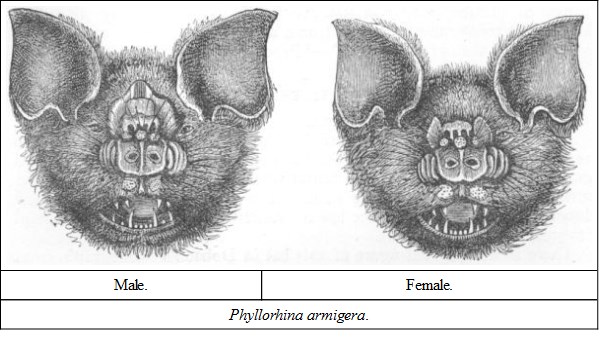
DESCRIPTION.—The hinder erect nose-leaf narrow, not so broad as the horse-shoe; upper edge sinuate, slightly elevated in the centre, and at either extremity; vertical ridges beneath well developed, prominent, enclosing moderately deep cells; wart-like granular elevations on each side above the eyes are usually greatly developed, forming large thickened longitudinal elevations extending forward on each side of the posterior erect nose-leaf, and backwards towards the frontal sac (Dobson). The colour varies.
SIZE.—Length of head and body from 3 to 4 inches; tail about 2.
This is the largest of this genus, and one of the most interesting of the species. My space will not admit of extensive quotations from those who have written about it, but there is a fuller description of it in Dr. Dobson's book, and a very interesting account of its habits by Capt. J. Hutton, in the 'Proceedings of the Zoological Society,' 1872, page 701.
NO. 65. PHYLLORHINA LEPTOPHYLLAHABITAT.—Khasya Hills.
DESCRIPTION.—Ears large, broad, triangular, with subacute tips; outer margin slightly concave; upper transverse nose-leaf small; upper edge simple, narrower than horse-shoe, thin; three vertical folds in front faintly descernible at base only; horse-shoe with small incision in centre of front free edge; frontal pore small, placed at some distance behind the transverse nose-leaf; fur and integuments dark throughout.—Dobson.
SIZE.—Length of head and body, 2 inches; tail, 1-6/10.
NO. 66. PHYLLORHINA GALERITAHABITAT.—Central India, Deccan.
DESCRIPTION.—"Ear comparatively small, as broad as long; inner margin very convex forward; outer margin slightly concave beneath the tip; nose-leaf as in P. larvata, but the transverse terminal leaf is more rectangular; the superior margin less convex, and its concave front surface is marked by three very prominent vertical ridges; frontal pore small, indistinct, not larger than in the females of P. larvata."—Dobson.
SIZE.—Head and body about 2 inches; tail, 1 inch.
NO. 67. PHYLLORHINA BICOLORHABITAT.—India (N. W. Himalaya), Nicobar Islands.
DESCRIPTION.—Fur above reddish chestnut; the base of the hairs pale reddish-white, or base of hair pure white, the tip, dark reddish-brown. Ears as long as the head, broad; the lower half of the inner margin very convex; the summit of the ear conch rounded off broadly as far as a point on the outer side, where a slight but distinct flattening occurs, and indicates the position of the tip. Horse-shoe small, square; the concave front surface divided into four cells by three distinct vertical ridges; no secondary leaflets external to the horse-shoe; frontal sac distinct in males, rudimentary in females (Dobson). Blyth includes this bat in his Burmese Catalogue, but does not say much about it.
GENUS COELOPSPossesses the general characteristics of Rhinolophus, but the tail and calcanea wanting entirely; the intercrural membrane acutely emarginate to the depth of a line even with the knees; ears large, broad and rounded; the summit of the facial membranes rising abruptly, obtusely bifid, bent forward; fur long, delicately fine.—Jerdon.
Dental formula: Inc., 1—1/4; can., 1—1/1—1; premolars, 2—2/2—2; molars, 3—3/3—3.
NO. 68. COELOPS FRITHIIFrith's Tailless Bat (Jerdon's No. 29)HABITAT.—The Sunderbunds, Bengal.
DESCRIPTION.—Colour dusky or blackish; the fur tipped with ashy brown above, paler and somewhat ashy beneath; membranes fuscous.
SIZE.—Length, 1-7/8 inch; membrane beyond ¾ inch; forearm, 1¾.
This bat is rare. The above description, given by Jerdon, is based on one specimen sent to Mr. Blyth by Mr. Frith, who obtained it in the Sunderbunds. It also inhabits Java. Dr. Dobson examined a specimen from thence in the Leyden Museum. He says: "Calcanea and tail very short," whereas the above description says entirely wanting. "The ears are funnel-shaped, and thickly covered with fine hair. Metacarpal bone of thumb very long; the wing membrane enclosing the thumb up to the base of the claw; wing to the tarsus close to the ankles; feet very slender; toes with strong claws."
GENUS RHINOPOMAEars moderate, but joined above, as in the Megaderms; the nostrils at the end of the muzzle, with a little lamina above, forming a kind of snout; tail slender and joined at the base with the intercrural membrane, but extending far beyond it.
Dental formula: Inc., 2/4; can., 1—1/1—1; premolars, 1—1/2—2; molars 3—3/3—3.
NO. 69. RHINOPOMA HARDWICKIIHardwick's Long-tailed Leaf Bat (Jerdon's No. 30)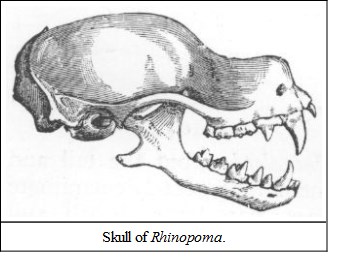
HABITAT.—All over India, Burmah and Malayana.
DESCRIPTION.—Muzzle long, thick, truncated, and surrounded by a small leaf; tragus oblong, bi-acuminate; forehead concave with a channel down the centre; fur soft and very fine, dull brown throughout; face, rump, and part of abdominal region naked.—Jerdon.
SIZE.—Head and body, 2-6/10 inches; tail, 2½; expanse, 13.
Frequents old ruins, caves, and clefts in rocks.
SUB-FAMILY NOCTILIONIDÆBats without facial membranes; with short obtuse and bull-doggish heads; large lips.
GENUS TAPHOZOUSHave a small rounded indenture on the forehead; no raised lamina on the nostrils; the head pyramidal; eyes rather large; ears moderate in size and not joined at the base, but widely apart; the tip of the tail free above the membrane, which is much longer.
The males have a transverse cavity under the throat; wings long and narrow, collapsing with a double flexure outwards; fur soft and velvety. (Dobson includes this genus in his Family Emballonuridæ.)
Dental formula: Inc., 1—1/4; can., 1—1/1—1; premolars, 2—2/2—2; molars, 3—3/3—3; premaxillaries cartilaginous, supporting only one pair of weak incisors with a gap between them.
NO. 70. TAPHOZOUS LONGIMANUSThe Long-armed Bat (Jerdon's No. 31)HABITAT.—India generally.
DESCRIPTION.—"Ears oval, with many distinct folds, naked except at the base; tragus securiform; fur thick, close, fuscous-black; or dark fuscous-brown above; beneath paler, except on the throat, the hairs being conspicuously tipped with grey, the upper hairs being all white at their base; face nude, and the membrane dark brownish-black" (Jerdon). The gular sac, though represented in the male, is almost absent in the female, being but a rudimentary fold of skin; in this it differs from another common Indian species, T. saccolaimus, in which the gular sac is well developed in both sexes, though larger in the male.
SIZE.—Length, 5 inches; expanse, 15 to 16; tail, 1; fore-arm, 2-5/8; tibia, 1 inch.
This bat frequents old buildings, dark cellars, old ruins, &c.; the young are fulvescent, and become darker with age. Blyth states that it has a surprising faculty for creeping about on the vertical board of a cage, hitching its claws into the minute pores of the wood.
NO. 71. TAPHOZOUS MELANOPOGONThe Black-bearded Bat (Jerdon's No. 32)HABITAT.—Common about Calcutta, East Coast of India, Burmah, and Cochin China.
DESCRIPTION.—"No gular sac, the openings of small pores appearing along a line corresponding to the position of the mouth of the gular sac in other species; in some male specimens the hair behind these pores is very long, forming a dense black beard" (Dobson). Ears moderate, oval, with the outer margin extending under the eyes, dilated into a large rounded lobe; the tragus leaf-shaped; the head, muzzle, and chin covered with short hairs.
SIZE.—Length of head and body about 3½; tail, 2/3; wing expanse, 14 inches.
Horsfield says it occurs in caves in Java inhabited by the esculent swallows (Collocalia nidifica), the gelatinous nests of which are used for soup by the Chinese. Dobson remarks that the black beard is not always developed in the males; he conceives it to be owing to certain conditions, probably connected with the amorous seasons. In five males in the Indian Museum the beard is well developed; he found that only two per cent. of the Cochin China specimens in the Paris Museum possessed it.
NO. 72. TAPHOZOUS SACCOLAIMUSThe White-bellied Bat (Jerdon's No. 33)HABITAT.—Peninsula of India, Burmah, and Ceylon.
DESCRIPTION.—"Muzzle angular, naked, very acute; nostrils small, close; ears distant, shorter than the head, large inner margin recurved, outer margin dilated, reaching to the commissure of the mouth; tragus wide, securiform (i.e. axe-shaped); fur short, smooth, blackish on the head, chestnut brown on the back; beneath, dirty-white or black brown above with white pencillings; pure white below" (Jerdon). Dobson says of the fur: "above, white at the base, the terminal three-fourths of the hairs black, with a few irregular small white patches on the back; beneath dark brown." The gular sac is to be found in both sexes, but somewhat larger in the males.
SIZE.—About 5 inches; wing expanse, 17.
NO. 73. TAPHOZOUS THEOBALDIHABITAT.—Tenasserim.
DESCRIPTION.—The gular sac is absent in both sexes; ears larger than in any others of the sub-genus; the muzzle, from the corners of the eyes downwards, naked.
SIZE.—Head and body about 3-1/10 inches; tail, 1¼.
NO. 74. TAPHOZOUS KACHHENSISHABITAT.—Kachh, N. W. India.
DESCRIPTION (apud Dobson).—"Gular sac absent in both male and female; its usual position indicated in the male by a semi-circular fold of skin and nakedness of the integument in this situation; in other respects similar to T. nudiventris. The deposits of fat about the tail very large."
SIZE.—Head and body about 3 inches; tail, 1¼.
T. nudiventris, above alluded to, is an inhabitant of Asia Minor, Egypt, and Nubia; similar to the above, only that it has a small gular sac in the male, of which a trace only exists in the female. Its most striking peculiarity is the deposit of fat at the root of the tail, which may possibly be for purposes of absorption during the dormant winter season.
GENUS NYCTINOMUS"Ears broad, short, approximate or connate with the outer margin, terminating in an erect lobe beyond the conch; tragus small, concealed" (often very small and quadrate, but never reduced to a mere point, as in Molossus—Dobson); "wings narrow, folded as in Taphozous; intercrural membrane short, truncate; tall free at the tip; feet short, with strong toes; muzzle thick; lips tumid, lax; upper lip with coarse wrinkles."—Jerdon.
Dental formula: Inc., 2/6 or 2/4; can., 1—1/1—1; premol., 2—2/2—2; mol., 3—3/3—3.
NO. 75. NYCTINOMUS PLICATUSThe Wrinkle-lipped Bat (Jerdon's No. 34)HABITAT.—India generally.
DESCRIPTION.—Muzzle broad and thick; upper lip overhanging the lower, marked by vertical wrinkles; ears large and quadrilateral; outer margin ending in a decided anti-tragus; tail thick; the lower part of the leg is free from the wing membrane, which however, is connected with the ankle by a strong fibrous band; fur dense, smoky or snuff brown above (or bluish black—Dobson); paler beneath.
SIZE.—Head and body about 2-1/10 inches; tail, 1-1/10. Jerdon gives length, 4¼ to 4-1/10; expanse, 13½; tail, 1¾.
This bat is common about Calcutta, frequenting ruins, dark places and hollow trees. It is allied to N. tenuis (Horsfield), and it is mentioned as inhabiting hollow trees in such numbers as to attract attention by the hissing noise from within, every available spot in the interior being occupied. A synonym of the genus is Dysopes.
NO. 76. NYCTINOMUS TRAGATUSHABITAT.—India generally.
DESCRIPTION.—This differs from the last in having the wing membrane from the ankles, and in the free portion of the tail being shorter; ears united at the base; tragus broad and rounded above, partially concealed by the large anti-tragus.
SIZE.—About the same as the last.
SUB-FAMILY VESPERTILIONIDÆThese bats have simple nostrils, as in the frugivorous ones, with no complications of foliated cutaneous appendages; the muzzle is conical, moderately long, and clad with fur; the ears wide apart; the inner margins springing from the sides, not the top of the head; the tragi are large; eyes usually very small, and the tail, which is long, is wholly included in the membrane.
Dentition (usually): Inc., 2—2/6; can., 1—1/1—1, premol., 3—3/3—3; mol., 3—3/3—3. The upper incisors are small, and placed in pairs near the canines, leaving a gap in the centre. The lower ones sharp-edged and somewhat notched. At birth there are twenty-two teeth, which are shed, and replaced by others, with sixteen additional ones, the adult bat having thirty-eight teeth.
GENUS PLECOTUSEars very large, united at the base; outer margin of the ear conch terminating opposite the base of the tragus, the inner margin with an abrupt rounded projection directed inwards above the base; tragus very large, tapering upwards, with a lobe at the base of the outer margin.
Dentition: Inc., 2—2/6; can., 1—1/1—1; premolars, 2—2/2—2; molars, 3—3/3—3.
The English species P. auritus is very common there, and also in France; its ears are nearly as long as its body, yet, when reposing, they are so folded as to be almost out of sight. The Indian species is only a variety distinguishable by its yet longer ears ("and comparative shortness of the thumbs"—Dobson).
NO. 77. PLECOTUS AURITUS vel HOMOCHROUS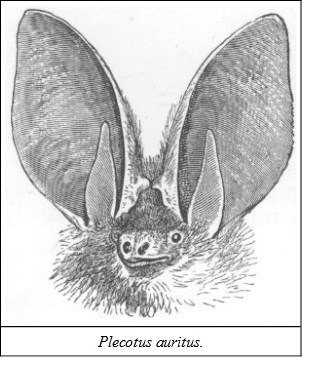
HABITAT.—The Himalayas and the Khasia Hills.
DESCRIPTION.—Head slightly raised above the face-line; ears nearly as long as the fore-arm, joined by a low band across the forehead at the bases of their inner margins; wings from the base of the toes; feet slender; tip of the tail free; fur silky, short, and of a uniform dull brown.
SIZE.—Head and body, 1·7 inch; ears, 1·55 (ears of English type of same size, 1·4 inch); tail, 1·7 inch. Jerdon gives larger results, but I put more reliance on Dobson's figures.
GENUS VESPERUGOBats with very broad and obtuse muzzles; the glandular prominences much developed between the eyes and the nostrils; crown of the head flat; but what distinguishes it from the following genus, Scotophilus, is the presence of four incisors in the upper jaw, whereas Scotophilus has two only—otherwise the two genera are very similar.
NO. 78. VESPERUGO NOCTULAHABITAT.—Nepal.
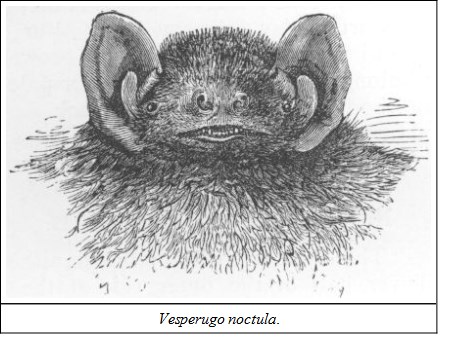
DESCRIPTION.—Head broad and flat; ears oval and broad; the outer margin convex, reflected backwards, and forming a thick lobe terminating close to the angle of the mouth; tragus short and curved inwards; muzzle devoid of hair; fur dark reddish brown.
NO. 79. VESPERUGO LEUCOTISHABITAT.—Deserts of Northern India, and Beluchistan.
DESCRIPTION.—"Ears, sides of face, about the eyes, interfemoral membrane, antehumeral membrane, and that portion of the wing membrane along the sides of the body, white, very translucent; remaining portion of wing membrane sepia, traversed by very distinct reticulations; fur on the upper surface black at the base of the hairs for about half their length, remaining portion light yellowish brown; beneath the same, but paler, almost white."—Dobson.



